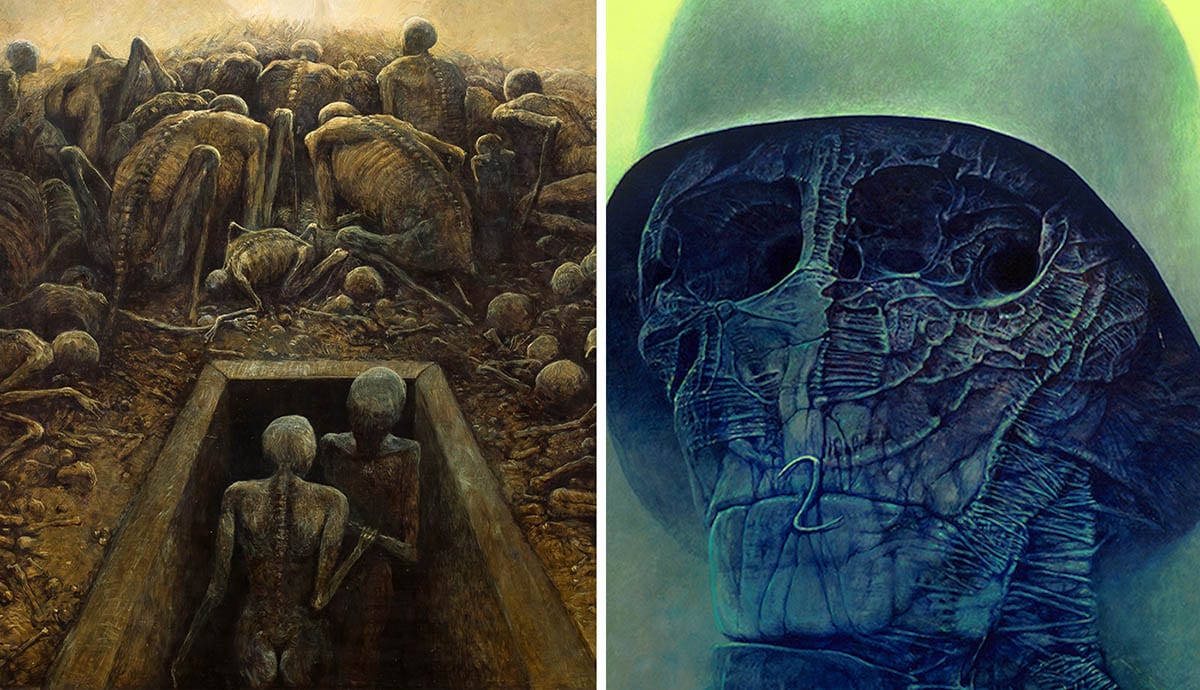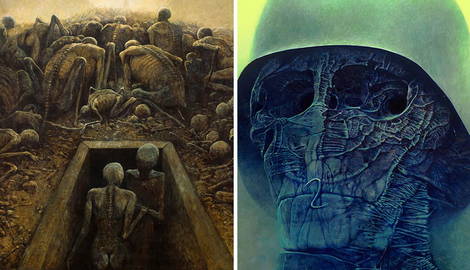
A surrealist painter, a person desensitized to war and tragedy, an award-winning artist, a creative photographer, and a murder victim; these descriptions all apply to one man: Zdzislaw Beksinski. The Polish-born artist lived through endless amounts of pain and suffering throughout his life, from world war to suicide and cancer. Living through so much hardship may beat down some, but Zdzislaw Beksinski was able to channel his pain into his artworks, leaving behind hundreds of gorgeous paintings and inspired fans.
The Early Life Of Zdzislaw Beksinski

Zdzislaw Beksinski was a surrealist painter born in the town of Sanok, Poland in 1929, who grew up in a war-torn nation occupied by Nazi Germany and the Soviet Union. At the start of World War II, Sanok’s population was about 30% Jewish, nearly all of which was eliminated by the war’s end. Even non-Jewish Poles were persecuted by the Germans and this was only worsened by the increasing Soviet presence. Approximately 5.6 million Poles died as a result of the German occupation, with about 150,000 more deaths due to the Soviet occupation. While little is known about the specifics of the artist’s childhood, it is reasonable to infer that living in Poland at such a time would’ve been brutal for anyone, let alone a child.
As a young man, Zdzislaw Beksinski studied architecture at the Kraków University of Technology and completed his education in 1952. Afterward, he worked as a construction site supervisor and bus designer, both jobs that Zdzislaw Beksinski absolutely hated. He began pursuing art during the mid-1950s and was interested in photography and sculpting, and eventually became a surrealist painter. Although he had no formal training in the arts, he was successful in selling his work even in the early days of his career. The artist often sold out exhibitions of his art and thoroughly impressed local critics.
The Meaning Behind The Surrealist Painter’s Work

Zdzislaw Beksinski’s work can be described as abstract and surrealist; always having been rather disturbing, depicting somber scenes of death, decay, distorted faces, and deformed bodies. While all of his work was rather dark, his initial work focused on dystopian apocalyptic landscapes and utilized expressionistic color while his later work was more abstract, formalistic, and used a muted color palette. His early photography can be seen as a clear influence on his later paintings, both containing fragmented and warped figures. The photographs give us a clue to the images the surrealist painter was drawn to again and again.
While it is undeniable that his work includes nightmarish imagery, the artist often stated that his work was not inherently dark, claiming that his paintings didn’t have any particular meaning and advising viewers to interpret them however they’d like. Many art critics and historians have inferred that the frightening subject matter of his work stems from his childhood spent during one of the most gruesome wars in human history, but the artist never openly confirmed the rumors and left much of his work’s symbolic meaning up in the air.

Regardless of Zdzislaw Beksinski’s denial of intentional meaning behind his work, there are some seemingly purposeful nods to figurative significance, especially in the context of his past. For example, in one of his paintings, a faceless figure is depicted, made up of intertwining wood-like material and wearing a war helmet very reminiscent of those of the Nazis.
On top of this, the painting stands out for its use of the color Prussian blue, named after the chemical used to create the pigment, Prussic acid also known as hydrogen cyanide. This Prussic acid was used in the Second World War to create a poison known as Zyklon B which was used in the gas chambers at many concentration camps, staining the walls with that familiar Prussian blue color.
While it is possible that Zdzislaw Beksinski was unaware of the horrible history behind Prussian blue, it is definite that living through the realities of the war must have been incredibly difficult for him. Zdzislaw Beksinski was only 16 when the war finally ended and even afterward his nation remained under Communist control for decades. Poland gained independence from the USSR in 1989, a few months after the artist’s 60th birthday.

Further supporting the idea that there is an intended meaning behind his art, in a painting of a grim reaper-like figure peering over an empty cradle, a wall in the background reads the Latin phrase “In hoc signo vinces” which translates to “In this sign, thou shalt conquer.” A book published in 1960 with that same Latin phrase as its title was written by George Lincoln Rockwell, the founder of the American Nazi Party.
The book was analogous to an American Mein Kampf and Rockwell unabashedly believed in and spread Neonazism and white supremacist ideology. Just a few years after ‘In Hoc Signo Vinces’ was written, Rockwell published another Neonazi manifesto, the racist book filled with anti-Semitism was fittingly titled ‘White Power,’ making Rockwell’s extremist beliefs abundantly clear.
A biography written on Rockwell by Frederick Simonelli in 1999 was titled ‘American Führer’ directly comparing him to Adolf Hitler. Knowing the history behind the Latin phrase and the man that popularized it, the inclusion of it in Zdzislaw Beksinski’s painting contradicts his statements and seems to almost indubitably prove a deliberate and calculated symbolic significance behind his work.
The Quality of His Art and the Inspiration Behind it

From a technical standpoint, his art was incredibly detailed and precise, utilizing advanced oil painting techniques. From an emotional perspective, his art is even more impressive, just looking at some of his paintings can be difficult to stomach, while at the same time being quite moving.
His work is hauntingly beautiful and even horrifying at times, without ever drawing upon traditional horror tropes. No matter what painting of his you look at, it’s sure to be surprisingly original and uniquely chilling. When discussing his objectives, Zdzislaw Beksinski commented that he “wishes to paint in such a manner as if [he] were photographing dreams.”
He took inspiration from both classical music and rock, often listening to it while painting and drawing. Strangely, Zdzislaw Beksinski never seemed to partake in the consumption of other forms of art, not known to enjoy literature or even other artists’ paintings. Just like his artwork, Zdzislaw Beksinski himself remained somewhat of a mystery to the public for much of his life. In the late 1970s, Beksinski burned a number of his paintings in his backyard, forever guarding work he called “too personal” from the public eye. The subject matter of these paintings is completely unknown and it appears as though it will always remain that way as Zdzislaw Beksinski took this secret to the grave.
Late Work

In the 1980s, Zdzislaw Beksinski gained more success around the world. His work sold more and more particularly in Japan, France, and the United States. During this period his work simplified, choosing to use a restricted and subdued color palette and further distinguishing the style of his paintings from others popular at the time.
In this era, Zdzislaw Beksinski also created a series of paintings that included a number of crosses, though it is unclear if this motif is a religious reference or not. It is highly unlikely that the crosses were an endorsement of Christian beliefs and many art historians believe that they were perhaps a reference to the crucifixion and the religious persecution he saw growing up in Poland. In the 1990s, Beksinski began using computers and the internet for artistic purposes, experimenting with digital art, photo manipulation, and photography which he often published online.
Personal Life

From what is known about the surrealist painter’s personal life, it was fairly traditional and mundane. He married Zofia Helena Stankiewicz in 1951 and they remained married for the rest of her life. In 1958, the couple gave birth to their first and only child, Tomasz Sylwester Beksinski, who later became a radio presenter, movie translator, and music journalist. While friends and family members say that Beksinski was a friendly, pleasant, and seemingly cheerful person, his private life was riddled with tragedy.
He was known to be somewhat anxious and thought to have suffered from Obsessive-Compulsive Disorder. He didn’t enjoy leaving Poland and refused to attend the exhibitions of his own art, stating that it was a “great stress” to him.
In 1998, Beksinski’s wife of 47 years passed away from cancer. Only a year later Beksinski’s son committed suicide on Christmas Eve at just 41 years old, leaving his father to find his body. Beksinski continued to create new artworks until his untimely death in February of 2005. He was found dead in his Warsaw home with 17 stab wounds.
Prior to his death, 75-year-old Beksinski had gotten into an argument with Robert Kupiac, the teenage son of his caretaker. The fight began when Kupiac demanded a loan of around 100 dollars and stabbed Beksinski repeatedly when he refused to comply. Kupiac was sentenced to 25 years in prison in November of 2006 at just 20 years old.
Zdzislaw Beksinski’s Legacy

Zdzislaw Beksinski’s work left behind an impressive mark on the numerous surrealist painters and the movement as a whole, forever changing it with the unforgettable, harrowing beauty of his art. After his death, Burning Man erected a cross in his memory, and in 2006 a museum dedicated to him and his work opened in his hometown of Sanok, Poland. His collections also feature in the National Museum in Wroclaw and the National Museum in Warsaw. Additionally, he was a recipient of the Order of Polonia Restituta (translated as “Order of the Rebirth of Poland”), a Polish award recognizing outstanding excellence and achievement in art, science, sport, culture, education, economics, among many other fields and disciplines.
While he received his fair share of critical and social acclaim, cited as a major inspiration by Mexican film director Guillermo Del Toro, some found his work to be too disturbing and macabre for the general public to enjoy. A number of critics, art historians, and fans have pushed back against this idea, arguing that the fact that Beksinski’s art evokes fear and emotion in its viewers is evidence of its artistic merit and strength. Throughout his life and death, young creatives have continued to be inspired by his work; pieces of music, paintings, and even an online game called ‘Tormentum’ which was created in 2015– all pay tribute to his art.









